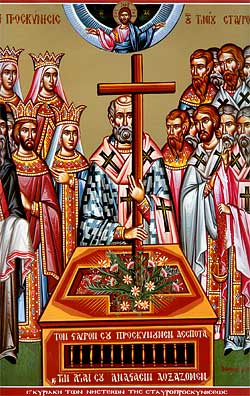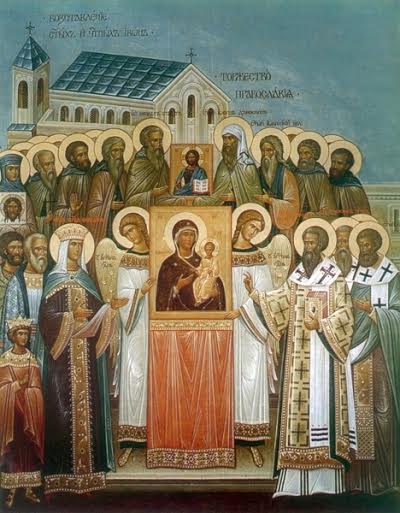The Third Sunday Of Great Lent: Sunday Of The Veneration Of The Holy Cross
 Introduction
Introduction
On the Third Sunday of Great and Holy Lent, the Orthodox Church commemorates the Precious and Life-Giving Cross of our Lord and Savior Jesus Christ. Services include a special veneration of the Cross, which prepares the faithful for the commemoration of the Crucifixion during Holy Week.
Historical Background
The commemoration and ceremonies of the Third Sunday of Lent are closely parallel to the feasts of the Veneration of the Cross (September 14) and the Procession of the Cross (August 1). Not only does the Sunday of the Holy Cross prepare us for the commemoration of the Crucifixion, but it also reminds us that the whole of Lent is a period when we are crucified with Christ.
As we have “crucified the flesh with its passions and desires” (Galatians 5:24), and will have mortified ourselves during these forty days of the Fast, the precious and life-giving Cross is now placed before us to refresh our souls and encourage us who may be filled with a sense of bitterness, resentment, and depression. The Cross reminds us of the Passion of our Lord, and by presenting to us His example, it encourages us to follow Him in struggle and sacrifice, being refreshed, assured, and comforted. In other words, we must experience what the Lord experienced during His Passion - being humiliated in a shameful manner. The Cross teaches us that through pain and suffering we shall see the fulfillment of our hopes: the heavenly inheritance and eternal glory.
Holy Martyr Codratus of Corinth
 In a time of persecution of Christians, many of the faithful fled to the mountains and caves. The mother of this Codratus did so. She was pregnant just at that time, and gave birth to Codratus in a forest, dying almost at once. He was kept safe and fed by the provi-dence of God and his guardian angel. Codratus grew up in solitude with nature. He who gave manna from heaven to the Israelites in the wilderness released a sweet dew from a cloud onto the mouth of the child Codratus. When he was twelve years old, he went down to the town, and there some good people took a fancy to him and educated him. He studied medicine and then began to heal the sick, using both natural medicines and, more importantly, the spiritual power and prayer which had been with him from childhood. When a new persecution arose under Decius, Codratus was taken for trial and thrown into prison. Five of his friends stood beside him and confess-ed the name of Christ. They were: Cyprian, Dionysius, Anectus, Paul and Crescens. They were all dragged through the streets and struck with sticks and stones by the unbelievers, especially by the children, until they arrived at the scaffold. Here the martyrs prayed to God and were beheaded with the sword. A spring of water gushed out onto the earth at the spot, which to this day is called by Codratus's name and commemorates the heroic death for Christ of the holy six. They suffered with honour for the truth in Corinth in the year 250, in the time of the Emperor Decius and his governor Jason.
In a time of persecution of Christians, many of the faithful fled to the mountains and caves. The mother of this Codratus did so. She was pregnant just at that time, and gave birth to Codratus in a forest, dying almost at once. He was kept safe and fed by the provi-dence of God and his guardian angel. Codratus grew up in solitude with nature. He who gave manna from heaven to the Israelites in the wilderness released a sweet dew from a cloud onto the mouth of the child Codratus. When he was twelve years old, he went down to the town, and there some good people took a fancy to him and educated him. He studied medicine and then began to heal the sick, using both natural medicines and, more importantly, the spiritual power and prayer which had been with him from childhood. When a new persecution arose under Decius, Codratus was taken for trial and thrown into prison. Five of his friends stood beside him and confess-ed the name of Christ. They were: Cyprian, Dionysius, Anectus, Paul and Crescens. They were all dragged through the streets and struck with sticks and stones by the unbelievers, especially by the children, until they arrived at the scaffold. Here the martyrs prayed to God and were beheaded with the sword. A spring of water gushed out onto the earth at the spot, which to this day is called by Codratus's name and commemorates the heroic death for Christ of the holy six. They suffered with honour for the truth in Corinth in the year 250, in the time of the Emperor Decius and his governor Jason.
40 Holy Martyrs of Sebaste
 In the year 313 Saint Constantine the Great issued an edict granting Christians religious freedom, and officially recognizing Christianity as equal with paganism under the law. But his co-ruler Licinius was a pagan, and he decided to stamp out Christianity in his part of the Empire. As Licinius prepared his army to fight Constantine, he decided to remove Christians from his army, fearing mutiny.
In the year 313 Saint Constantine the Great issued an edict granting Christians religious freedom, and officially recognizing Christianity as equal with paganism under the law. But his co-ruler Licinius was a pagan, and he decided to stamp out Christianity in his part of the Empire. As Licinius prepared his army to fight Constantine, he decided to remove Christians from his army, fearing mutiny.
One of the military commanders of that time in the Armenian city of Sebaste was Agricola, a zealous champion of idolatry. Under his command was a company of forty Cappadocians, brave soldiers who had distinguished themselves in many battles. When these Christian soldiers refused to offer sacrifice to the pagan gods, Agricola locked them up in prison. The soldiers occupied themselves with prayer and psalmody, and during the night they heard a voice saying, “Persevere until the end, then you shall be saved.”
Sunday of Orthodoxy
 Rejoicing today in the triumph of Orthodoxy on this first Sunday of Lent, we joyfully commemorate three events: one event belonging to the past; one event to the present; and one event which still belongs to the future.
Rejoicing today in the triumph of Orthodoxy on this first Sunday of Lent, we joyfully commemorate three events: one event belonging to the past; one event to the present; and one event which still belongs to the future.
In the name of the Father, and of the Son, and of the Holy Spirit. Amen.
Rejoicing today in the triumph of Orthodoxy on this first Sunday of Lent, we joyfully commemorate three events: one event belonging to the past; one event to the present; and one event which still belongs to the future.
Repose of Saint Nikolai of Zhicha
![]() Saint Nikolai of Zhicha, “the Serbian Chrysostom,” was born in Lelich in western Serbia on January 4, 1881 (December 23, 1880 O.S.). His parents were Dragomir and Katherine Velimirovich, who lived on a farm where they raised a large family. His pious mother was a major influence on his spiritual development, teaching him by word and especially by example. As a small child, Nikolai often walked three miles to the Chelije Monastery with his mother to attend services there.
Saint Nikolai of Zhicha, “the Serbian Chrysostom,” was born in Lelich in western Serbia on January 4, 1881 (December 23, 1880 O.S.). His parents were Dragomir and Katherine Velimirovich, who lived on a farm where they raised a large family. His pious mother was a major influence on his spiritual development, teaching him by word and especially by example. As a small child, Nikolai often walked three miles to the Chelije Monastery with his mother to attend services there.
Sickly as a child, Nikolai was not physically strong as an adult. He failed his physical requirements when he applied to the military academy, but his excellent academic qualifications allowed him to enter the Saint Sava Seminary in Belgrade, even before he finished preparatory school.

